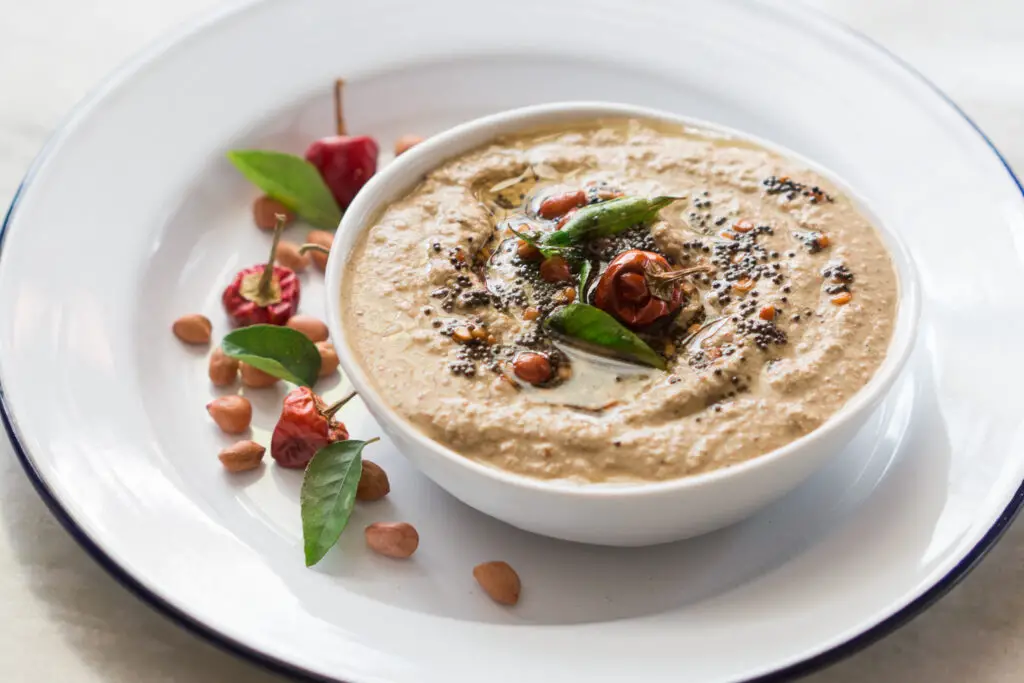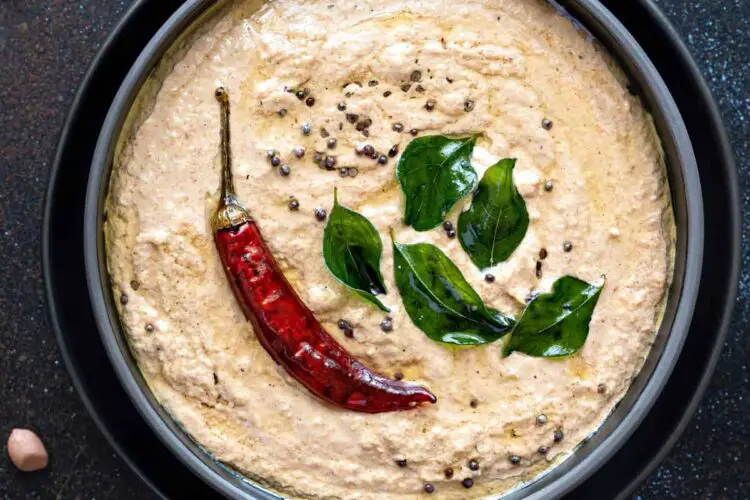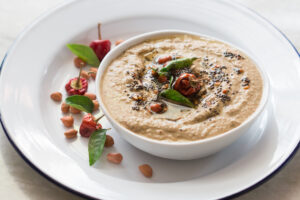Peanut chutney is a condiment that is popular in South Indian cuisine. It is made using roasted peanuts, which are ground into a smooth paste along with other ingredients like coconut, tamarind, garlic, and spices such as cumin and red chili powder. The paste is then tempered with mustard seeds, curry leaves, and other seasonings to give it a delicious flavor.
The chutney is usually served as a side dish or a dip with a variety of dishes such as dosa, idli, vada, and even rice. It is a great way to add some flavor and texture to your meal, and it is also quite nutritious, as peanuts are a good source of protein, fiber, and healthy fats.
In addition to its delicious taste, peanut chutney is also easy to make and can be customized to suit your taste preferences. You can adjust the amount of spice and tanginess by adding more or less tamarind or chili powder, and you can also experiment with different combinations of ingredients to create your own unique version of this popular condiment.

Ingredients for Peanut Chutney
- 1 cup roasted peanuts
- 1/4 cup grated coconut
- 1 small garlic clove
- 1 small piece of tamarind (or 1 tsp of tamarind paste)
- 1/2 tsp cumin seeds
- 1/2 tsp red chili powder
- Salt, to taste
- Water, as needed
For tempering:
- 1 tbsp oil
- 1/2 tsp mustard seeds
- 1/2 tsp cumin seeds
- A few curry leaves
Instruction for Peanut Chutney
- In a blender or food processor, add roasted peanuts, grated coconut, garlic, tamarind, cumin seeds, red chili powder, and salt. Add a little water and grind until you get a smooth paste. Add more water as needed to achieve your desired consistency.
- Transfer the peanut chutney to a serving bowl.
- In a small pan, heat oil over medium heat. Add mustard seeds and let them splutter. Add cumin seeds and curry leaves and fry for a few seconds.
- Pour the tempering over the peanut chutney and stir to combine.
- Serve peanut chutney with dosa, idli, vada, or rice.
Enjoy your delicious peanut chutney!
Tips and Variations
- Roasting the peanuts enhances their flavor and also makes them easier to grind into a smooth paste.
- Add water in small increments to achieve the desired consistency. If the chutney is too thick, add more water. If it’s too runny, add more peanuts.
- Adjust the amount of red chili powder to make the chutney more or less spicy. You can also add green chilies if you prefer.
- Fresh coconut, garlic, and curry leaves will give your chutney a better flavor.
- Tamarind adds tanginess to the chutney. You can adjust the amount of tamarind according to your taste preference.
Serving suggestions
- Peanut chutney is a popular side dish that is served with these South Indian breakfast dishes. It pairs well with their mild flavor and helps balance out the spices. It can be used as a spread on sandwiches and wraps. It adds a nutty flavor and a bit of spice to your sandwich.
- Peanut chutney can be served as a dip for vegetables, crackers, or chips. It’s a great alternative to traditional dips like hummus or salsa. The chutney can be served as a side dish with plain rice or biryani.
- Store leftover chutney in an airtight container in the refrigerator for up to 2-3 days.
FAQs
- Q: Is peanut chutney vegan?
A: Yes, It is usually vegan, as it is made with plant-based ingredients like peanuts, coconut, and spices. However, some recipes may use yogurt or other dairy products, so it’s important to check the ingredients.
- Q: Is peanut chutney gluten-free?
A: Yes, the chutney is gluten-free, as it doesn’t contain any wheat, barley, or rye. However, some recipes may use asafoetida, which may contain wheat flour, so it’s important to check the ingredients.
- Q: Is peanut chutney spicy?
A: The chutney can be as spicy or mild as you like. The spiciness can be adjusted by adding more or less red chili powder or green chilies.
- Q: Can I use raw peanuts?
A: It’s best to use roasted peanuts, as they have a better flavor and texture. However, if you don’t have roasted peanuts, you can use raw peanuts and roast them in a dry skillet or oven before using them.
Nutrition
| Calories | 93kcal |
| Carbohydrates | 23g |
| proteins | 1g |
| sodium | 5mg |
| potassium | 10mg |
| sugar | 22g |
| Vitamin A | 1IU |
| Vitamin C | 1mg |
| Fat | 1g |
| Iron | 1mg |
Conclusion:
In conclusion, peanut chutney is not just a condiment; it’s a culinary delight that brings together simplicity and taste. Add this easy-to-make recipe to your repertoire and watch it become a staple, adding flair to your
Also read:


